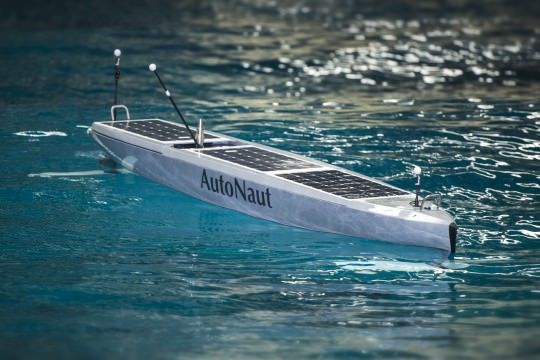Autonomous Surveying of Coastal Waters for Clean Seas
Published on by Water Network Research, Official research team of The Water Network in Technology
The wave-propelled AutoNaut unmanned surface vessel (USV) completed a short trial off the south-west coast of England to monitor the water quality by a sewage outfall.

5 metre AutoNaut ‘Jura’
AutoNaut demonstrated its ability to reliably operate in shallow waters whilst also recording and transmitting data. A suite of sensors aboard the USV worked in conjunction with satellite data from synthetic aperture radar (SAR). Analysis indicated that the seawater close to the outflow was not negatively affected.
The combination of technologies is pioneering for the application and the trial highlights the potential of this innovative approach to conduct long-term marine monitoring – including the reduction of costs and risks relative to conventional methods.
In the trial, commissioned by a UK water utility, sensors measuring water quality were installed in a 5-metre AutoNaut USV.
The mission aims were to detect the plume from a coastal sewage outfall and establish its characteristics. Contemporaneous satellite-based synthetic aperture radar (SAR) data was analysed to establish whether the same plume could be detected from space.
Surveying in rugged coastal waters presents additional challenges for any boat. For a USV, completion of a survey so close to land requires both the autonomous technology to be 100% reliable and the craft itself to have proven sea-worthiness.
The AutoNaut USV uses patented Wave Foil Technology to propel itself forward solely by the motion of the waves. It maintains an average of 3 knots and can operate in all sea conditions - with an auxiliary propeller in case of flat-calm conditions.
The craft is highly manoeuvrable and can confidently keep station within a 50-metre radius. Additionally, the boat has very little draft, having no sub-sea tethered mechanism, and is therefore able to work safely in shallow waters. Solar panels and a battery bank power a suite of sensors for the project objectives. This use of renewable energy enables very long-term missions to be completed – with no requirement for fuel.
Autonomy at sea, albeit with oversight from onshore operators, also removes the safety risks of personnel working offshore.
Read full article: Hydro International
Attached link
http://www.youtube.com/embed/LUWP97MWoI4Media
Taxonomy
- Technology
- Monitors
- Water Quality
- Impact Assessment
- Marine
- Water Monitoring
- Sewage
- Sewer Networks
- Oceanographic Survey
- Impact
- Marine Technologies
1 Comment
-
AutoNaut unmanned surface vessel is a great information technology innovation to help marine biology Greenical which is a global waters green technology.